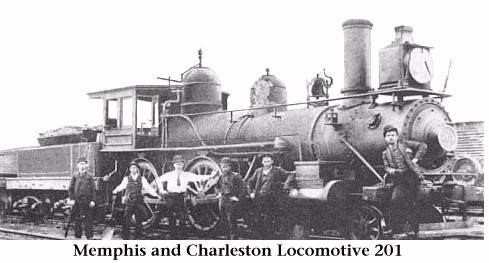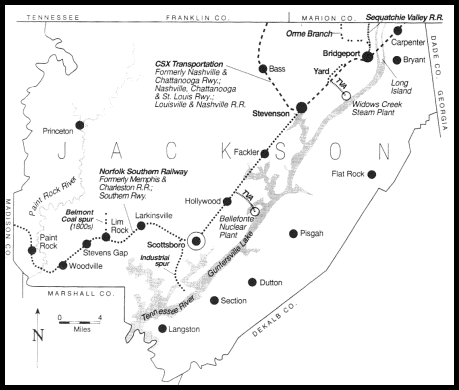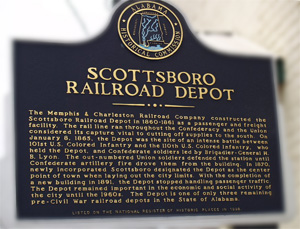The Early History of the Railroad in Scottsboro
The Memphis & Charleston Railroad began limited service over newly built segments of track in August of 1852. By May 1857, the line was offering regular service over the entire 272-mile route from Stevenson to Memphis.

With its link in Stevenson to the Nashville & Chattanooga Railroad, the Memphis & Charleston became part of the first contiguous rail route from the Atlantic Ocean to the Mississippi River.
The Memphis and Charleston Railroad was unique in many ways. 1) It was the first railroad to offer sleeper cars. 2) It was the only railroad to run east-west in what was to become the Confederacy. 3) It made more money from its passenger service than from its freight service. 4) It was not conceived and operated as a local branch railroad, but as a long-haul route. Direct routes to the east coast and the northeast were enabled by the decision of Memphis and Charleston planners and management to adopt a standard rail gauge and to lease usage rights from adjoining rail lines. . . . [Read more.]
On July 23, 2023, Dr. David Campbell, President of Northeast Alabama Community College and one of the key players in the efforts to save the depot, addressed the Jackson County Historical Society and recounted how the depot was saved by dedicated JHCA members.
The restoration of the Scottsboro Freight Depot was the product of years of effort on behalf of many dedicated volunteers. Read about the progress of our restorations in our depot timeline.
Learn more about the history of Scottsboro's rails and depot:

How did goods reach consumers deep in the American South before the railroad? Though
some freight came overland on pack animals or wagons, most goods arrived in the fledgling state of Alabama by steamboat and keelboat. But, as Donald Davidson so aptly noted about the Tennessee River before it was neutered by the TVA, is that "of all the great rivers east of the Mississippi, it [the Tennessee] has been least friendly to civilization...It could be used, but only at great hazard and on terms forbidding to commerce and industry." [Read more.]
Memphis & Charleston's Scottsboro Freight Depot, located at the junction of North Houston Street and Maple Avenue, is one of early Scottsboro's oldest surviving landmarks and was the vital center of Scottsboro’s first business district.

When the depot was built in 1859-61, it was considered a revolutionary idea. Only a small group of people envisioned a need for its existence. Although this was not the first freight depot in Jackson County, it was the first brick building in the small railroad town of Scott’s Mill. The new depot had no electricity, no running water, no telephone or telegraph system, and required only one man to dispense the services it provided.
The depot was less than a year old when the Civil War began, elevating the railroad's importance in the community, the state, and the nation. Before that war ended, men fought in armed combat to control the freight depot and its access to the rails. Musket ball holes found in the walls of the depot are silent, enduring testimony to the bloody skirmishes fought in and around the depot. [Read more.]
On the evening of January 6, 1865, a Confederate detachment of about 500 men crossed Sand Mountain and the Tennessee River, mustering at Bellefonte Landing. Some of the soldiers were wearing Union overcoats to disguise their affiliation.
Federal troops stationed in Scottsboro heard artillery in the distance during the day of January 7, but decided it was of no consequence. They became complacent and moved from their earthwork fortifications to the Scottsboro depot building. There, they were attacked on January 8 by the Confederate troops that had advanced from Bellefonte.
The Southerners were under the command of Brigadier-General Hylan Benton Lyon, a West Point graduate who, in the final months of the war, was personally directing what amounted to a group of guerillas.
In the course firefight that followed, Union reinforcements converging on Scottsboro from both Larkinsville and Bellefonte drove the Confederate troops toward Sauta.
We are fortunate to have a first-hand account of the skirmish written by Union Brigadier-General Charles Cruft. [Read more.]
The stations between Huntsville and Chattanooga were established before the Civil War, though most were destroyed during the war and later rebuilt. According to Jack Daniel, the Memphis and Charleston Railroad built a sawmill near Larkinville that was put into operation on April 10, 1866. The reason for this mill was to provide lumber to build stations along the railroad line. The M&C purchased the machinery for the new mill from the U. S. Military Railroad authorities, and a mill house was built and put into operation. (FN Daniel, p. 312)
Shortly after the war the N&C began construction of the Sequatchie Valley Branch to serve coal interests north of Bridgeport. The portion from Bridgeport to Jasper, Tenn., completed in 1867, was extended to Pikeville, Tenn., in 1894. The remnant of this branch constitutes the Sequatchie Valley Railroad, a shortline headquartered in South Pittsburg, Tennessee.
In the 1870s the expanding N&C was renamed the Nashville, Chattanooga & St. Louis Railway. Part of this expansion was the Orme Branch, a 10-mile spur originally known as the Dorans Cove Branch. Built in 1904, it was abandoned in 1942. The line diverged from the Sequatchie Valley Branch one mile north of Bridgeport, and terminated at Orme, Tenn., a coal mining settlement.
In 1879 a six-mile spur was constructed north from Lim Rock to the Belmont Coal Company mines which supplied coal to the connecting M&C for a few years before the spur's abandonment.
The M&C was operated by other railroads until the panic of 1893. J.P. Morgan reorganized and consolidated many rail lines, creating Southern Railway, which operated the former M&C.
In 1913 six Southern passenger trains served Jackson County each day, stopping at these
stations in Jackson County:
Among these were the Memphis Special and, later, the gas-powered Joe Wheeler and the diesel-powered Tennessean.
Paint Rock made history in 1931 when nine black men were pulled from a Southern freight train and charged with rape. Their controversial trials gained worldwide publicity.
The NC&StL mainline through Jackson County was part of that railroad's Chattanooga Division. The Dixie Flyer, the Dixie Limited and later the Georgian were passenger trains plying the "Dixie Line". The NC&StL merged into the Louisville & Nashville Railroad in 1957.

The map at the left shows the railroad stops in Jackson County at the turn of the century.
Railroad mail and passenger service in Jackson County ended in the 1960s, but freight traffic continues to grow. CSX Transportation, successor to L& N, retains an office in Bridgeport.
Based on the "Jackson County Railroad History," for The History of Jackson County, Alabama
(Alabama Heritage Series, 1998) by R. Daniel Proctor, 5728 Westover Dr., Knoxville, TN 37919 and on articles for the Jackson County Chronicle by Ann B. Chambless.




